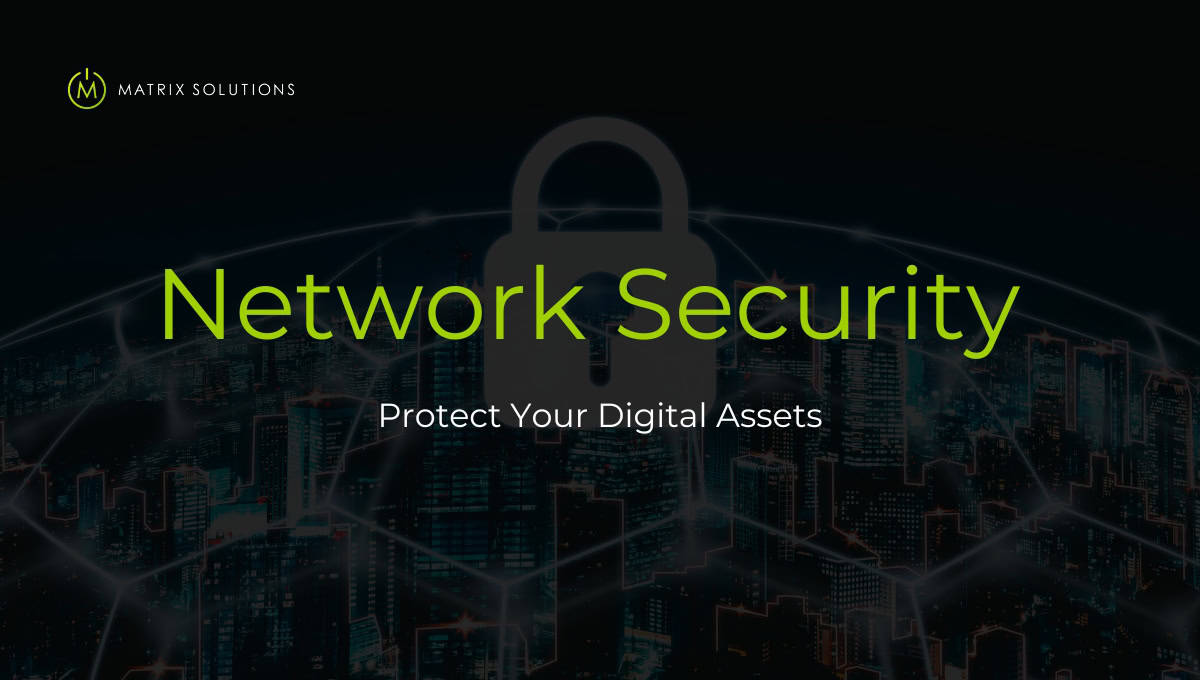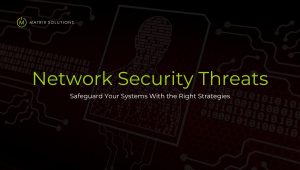Your business data is one of your most valuable assets, and keeping it safe requires more than a simple password. Effective network security is about protecting your systems, maintaining trust with clients, and ensuring your day-to-day operations run smoothly.
For small and medium-sized enterprises (SMEs), threats don’t only come from cybercriminals. Malware, Phishing, or even an accidental click by an employee can compromise sensitive information. A strong computer network security framework helps shield your systems against these risks, giving your business the resilience it needs in today’s digital environment.
In this blog, we’ll explain what network security means, why it matters, its types, common threats, and share practical steps you can take to strengthen your network protection.
Network Security in the SME Context
At its core, network security protects digital environments from unauthorised access, data breaches, and cyberattacks. For Australian SMEs, it underpins everything from managing client files to running business applications.
With smaller budgets and limited IT resources, SMEs are more vulnerable to threats and must rely on smart, cost-effective network security solutions. Compliance with Australian data protection laws adds to the pressure.
That’s why tailored network security services, such as firewalls, intrusion detection, and monitoring, are essential. The right network systems not only reduce downtime and risk but also safeguard clients and keep business operations running smoothly.
Why Network Security Matters for Your Business
Strong network security is crucial for safeguarding business data and keeping daily operations running smoothly. For SMEs, it’s not only about stopping. Cyberattacks are about building a secure and trustworthy foundation for growth.
Here’s why investing in the right network security solutions is critical:
- Protects sensitive data: Stops theft or misuse with effective computer network security.
- Keeps operations running: Reduces downtime and maintains system availability.
- Builds client confidence: Shows commitment to network and data security.
- Prevents financial losses: Reduces costs from breaches or poor IT network security.
- Safeguards reputation: Strong network protection helps avoid damage to credibility.
- Supports compliance: Tailored network security services meet Australian data standards.
Reliable network security systems are no longer optional; they are essential for safeguarding clients, preventing disruption, and keeping your business competitive.
Types of Network Security
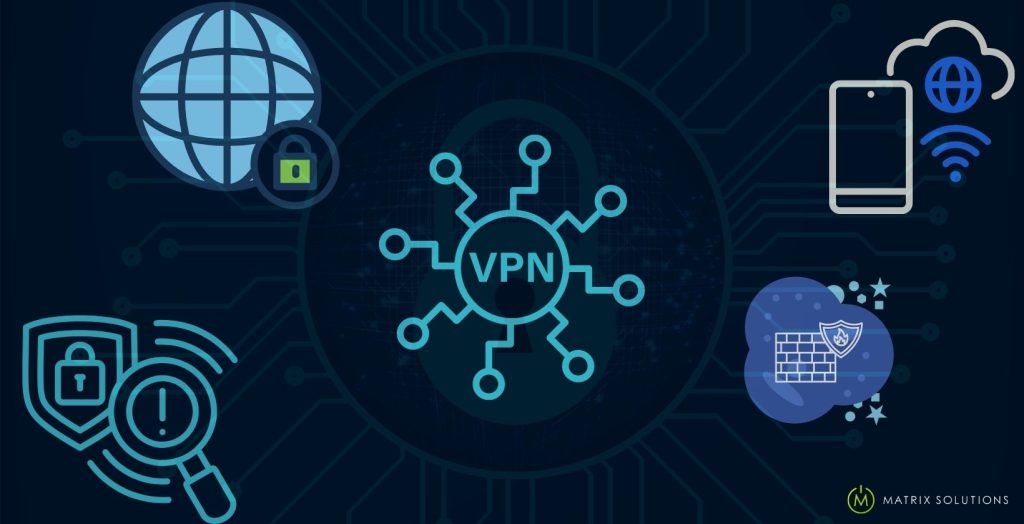
Modern network security combines different technologies to protect businesses from a wide range of threats. Each layer of defence strengthens your ability to safeguard data, maintain compliance, and ensure operations stay secure.
Here are some of the most important network security solutions used by SMEs today:
1. Firewalls
A firewall is often the first layer of computer network security. It filters traffic moving in and out of your systems, blocking anything that doesn’t meet approved rules. Firewalls can be hardware, software, or a mix of both.
By stopping unauthorised access and preventing malicious traffic, they give businesses a clear way to manage network protection and enforce security policies.
2. Intrusion Detection and Prevention Systems (IDPS)
Firewalls aren’t enough on their own, which is where IDPS comes in. An Intrusion Detection System (IDS) scans traffic for unusual behaviour, alerting administrators to possible attacks.
An Intrusion Prevention System (IPS) goes further by blocking malicious activity in real time. Together, these tools provide an additional layer of cyber network security, helping identify threats that bypass basic defenses.
3. Virtual Private Networks (VPNs)
VPNs secure communication by encrypting internet traffic between users and the corporate network. This ensures sensitive information stays private, even on public connections.
For SMEs with remote staff, VPNs are a practical network security service, allowing employees to safely access internal systems from anywhere while maintaining compliance with data security standards.
4. Network Access Control (NAC)
Network Access Control (NAC) manages who and what can connect to your systems. It checks devices for security status and user credentials before granting access.
NAC solutions can block or isolate risky devices, protecting sensitive areas of the network. This targeted control strengthens IT network security and reduces the chance of internal threats.
5. Encryption Techniques
Encryption converts data into unreadable code without the right key. It protects files stored on servers as well as information shared online. Both symmetric and asymmetric encryption methods are widely used to secure financial transactions, client records, and internal communication.
As a core part of computer network security systems, encryption ensures that even intercepted data remains safe and inaccessible.
Common Threats to Network Security
Businesses today face a constant stream of network security threats. Cybercriminals exploit weaknesses in systems, leading to data breaches, financial losses, and reputational damage.
Below are some of the most common risks and their impact on SMEs.
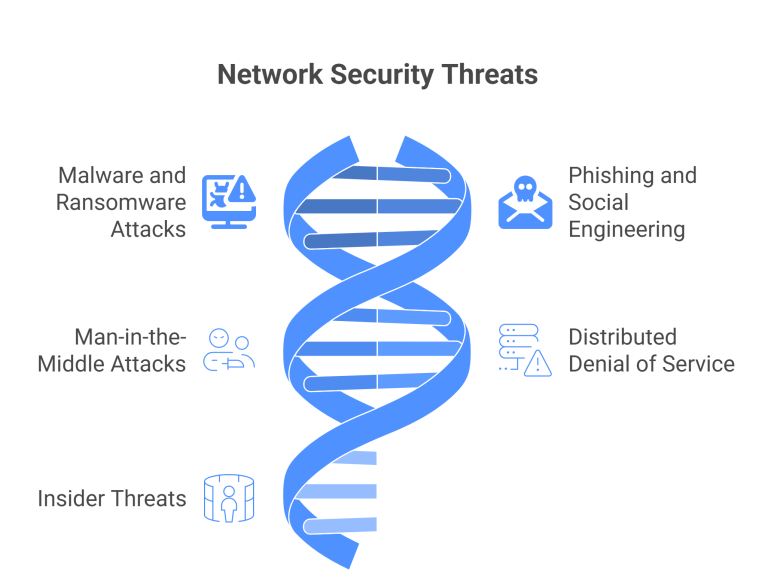
Malware and Ransomware Attacks
Malware is malicious software, viruses, trojans, or spyware, designed to damage or disrupt computer network security. Once inside, it can steal data, corrupt files, or slow systems, causing downtime and financial harm.
Ransomware, a more aggressive form of malware, encrypts files and demands payment for access. Such attacks highlight the importance of strong network security in computer network systems and backups are essential for business continuity.
Phishing and Social Engineering Attacks
Phishing targets employees by imitating trusted contacts through fake emails or websites. Once a user clicks a malicious link or shares login details, attackers gain access to sensitive information.
These scams threaten network and data security, leading to identity theft, fraud, or unauthorised entry into corporate systems. Regular training and layered network security solutions help reduce the risk.
Man-in-the-Middle (MitM) Attacks
In a MitM attack, criminals intercept communication between two parties, often over unsecured Wi-Fi. They can steal login details, alter transactions, or capture confidential information.
This type of cyber network security breach is especially damaging for industries like finance and healthcare, where stolen data directly impacts clients. Encryption and secure connections are key defences.
Distributed Denial of Service (DDoS) Attacks
A DDoS attack floods a network or server with excessive traffic, overwhelming resources until services crash. For online businesses, this can mean lost sales, downtime, and customer frustration.
Strong IT network security and monitoring systems help identify unusual traffic early, allowing businesses to maintain uptime and resilience.
Insider Threats
Not all risks come from outside. Insider threats, whether intentional or accidental, occur when staff, contractors, or partners misuse authorised access.
This could involve stealing trade secrets or unintentionally exposing data through phishing. Because insiders already have access to the security of a network, these incidents can be harder to detect. Effective policies, audits, and tailored network security services help reduce exposure.
Network Security Best Practices
Strong network security practices protect sensitive information, minimise downtime, and prevent costly breaches. By combining the right tools with employee awareness, SMEs can establish a reliable defence that keeps unauthorised users out, detects threats early, and supports long-term business continuity.
I. Regular Network Monitoring and Auditing
Ongoing network monitoring and auditing strengthen computer network security by detecting unusual activity before it escalates. These practices highlight vulnerabilities, reduce risks, and give businesses time to respond.
With tailored network monitoring and protection tools, SMEs can maintain visibility and stop threats before they impact operations.
Ready for proactive monitoring? Let Matrix Solutions set up custom alerts and reports, giving you real-time insights to stay ahead of cyber threats.
II. User Education and Awareness
Employees remain a critical part of IT network security. Training staff on phishing, password management, and secure handling of client data reduces the chance of user-driven breaches. Awareness programs ensure your team becomes an active layer of network protection.
III. Implementing Multi-Factor Authentication (MFA)
MFA adds another step to user logins, making it harder for attackers to access systems even if passwords are compromised. Integrating MFA into your network security systems ensures only verified users reach sensitive resources, protecting critical business assets.
IV. Regular Software and Hardware Updates
Outdated systems are a common entry point for cybercriminals. Regular patching of software and firmware strengthens cyber network security by closing known vulnerabilities. Managed update services keep your network security solutions current, reducing risk without adding complexity.
Stay protected effortlessly. Trust Matrix Solutions to manage your updates so you’re always protected against the latest threats.
V. Creating a Network Security Policy
A strong network security policy guides data access and response to threats, helping your team know exactly how to handle sensitive information. Policies set the foundation for secure behaviour, ensuring consistency and reducing the likelihood of breaches.
A clear network security policy defines how employees handle data, access systems, and respond to incidents. Policies provide consistency across the business, reduce errors, and help meet compliance standards. This foundation ensures your network security services remain effective as the business grows.
Network Security Services for SMEs
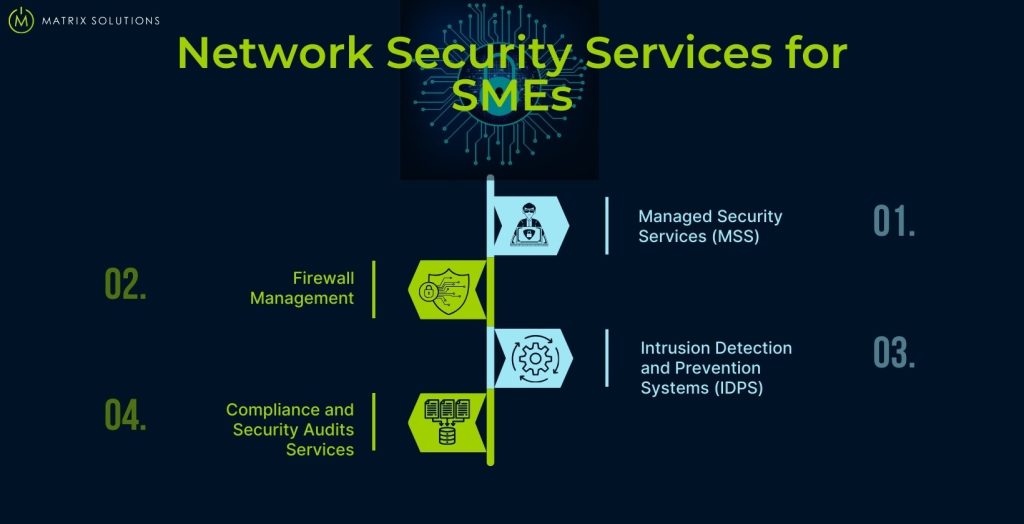
To enhance your network protection, SMEs can get specialised services that detect, prevent, and respond to threats. Key services include:
1. Managed Security Services (MSS)
Managed Security Services provide 24/7 monitoring and management of security infrastructure. These services include real-time threat detection, incident response, and proactive defense against emerging cyber risks.
2. Firewall Management
Firewalls are the first line of defense in any network security system. Managed firewall services protect from unauthorized access and malicious traffic. Providers handle the setup, configuration, and ongoing updates to maintain optimal firewall protection.
3. Intrusion Detection and Prevention Systems (IDPS)
Intrusion Detection and Prevention Systems monitor network traffic for signs of suspicious activity. IDPS detects threats, alerts security teams, or automatically blocks harmful traffic for quick mitigation of cyber threats.
4. Compliance and Security Audits Services
Regular audits identify vulnerabilities and ensure regulatory compliance. Compliance-focused services assess your security posture and provide detailed reports with actionable recommendations to improve your network architecture and meet regulatory requirements.
Don’t wait for a security breach. Contact Matrix Solutions for complete Managed IT Solutions tailored to your needs. Protect your network and secure your digital assets today!
Emerging Next-Gen Trends in Network Security
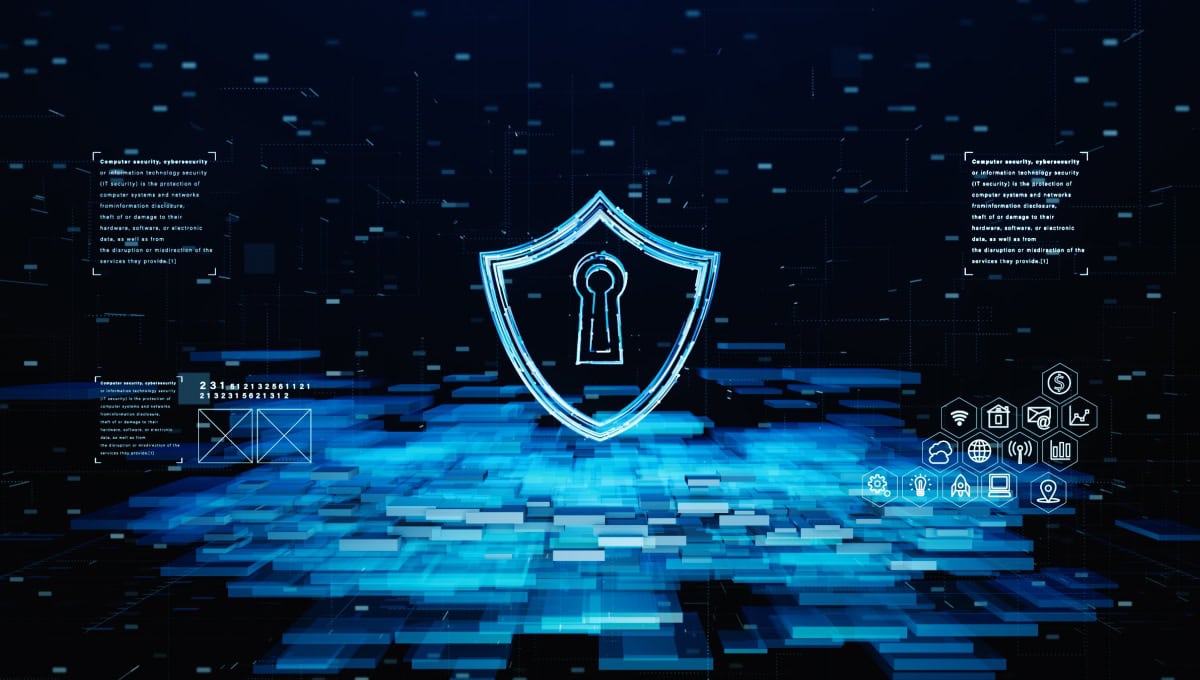
As cyber threats become more advanced, network security continues to evolve. SMEs and larger organisations alike are adopting new tools and frameworks to strengthen protection, improve efficiency, and reduce risks.
Here are some of the most important trends shaping the future of IT network security in 2025:
Artificial Intelligence and Machine Learning
AI and machine learning are transforming computer network security by detecting unusual activity patterns, analysing data in real time, and adapting to new attack methods. These technologies increase accuracy in identifying threats and speed up response times through automated analysis, giving businesses a proactive layer of network protection.
Zero Trust Security Model
Zero Trust is a cybersecurity framework. The Zero Trust approach assumes no user or device is trustworthy until verified, whether inside or outside the network. By applying strict access controls and verification checks, this model limits unauthorised access and reduces the risk of insider threats. It’s becoming a core network security solution for organisations managing sensitive data.
Security Automation
Automation streamlines network security services by managing tasks like threat detection, compliance checks, and incident response. Automated systems react faster than manual processes, reduce human error, and provide consistent responses to potential risks, lightening the workload on IT teams while strengthening overall security.
Integration of Cloud Security Solutions
With more businesses adopting cloud platforms, protecting data in storage and transit has become critical. Cloud-based network security systems offer scalability, encryption, and secure access protocols tailored to modern workplaces. These solutions adapt to business growth while ensuring reliable cyber network security in dynamic environments.
Building a Resilient Network Security Strategy
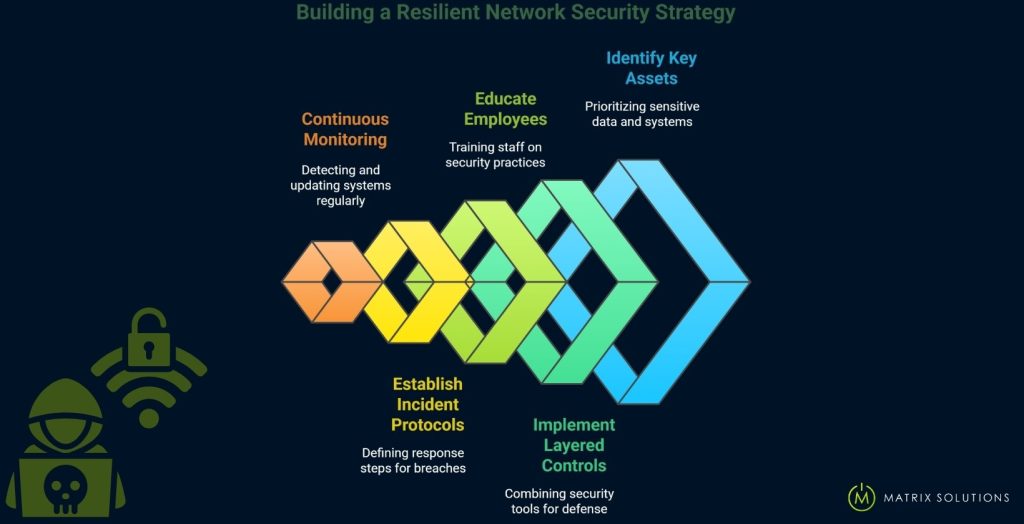
A strong endpoint protection strategy protects your business against evolving threats. Taking a proactive approach with layered network protection is far more effective than reacting to breaches after they occur. Below is a step-by-step guide to creating a comprehensive network security plan.
Steps to Develop a Comprehensive Network Security Plan:
1. Assess Current Security Measures: Audit your existing setup to uncover gaps, outdated systems, or weak points. Regular reviews strengthen computer network security and highlight areas needing attention.
2. Identify Key Assets and Risks: Prioritise sensitive data, applications, and systems. This allows you to focus IT network security resources where they matter most.
3. Implement Layered Security Controls: Combine firewalls, intrusion detection, and encryption to reduce the risk of a single failure point. A multi-layered defence is the foundation of modern network security solutions.
4. Educate Employees: Train staff on phishing awareness, password hygiene, and safe data handling. Well-informed employees are essential to preventing user-driven breaches.
5. Establish Incident Response Protocols: Define clear steps for containment, investigation, and recovery. A documented response plan ensures faster action and minimises damage.
6. Continuous Monitoring and Regular Updates: Use real-time monitoring to detect suspicious activity and keep all systems patched. Regular updates help protect against new exploits and maintain the effectiveness of network systems.
Conclusion: Secure Your Digital Future
Strong network security is no longer optional; it’s essential for protecting your business against growing cyber threats. By taking a proactive approach, applying layered network protection, and staying aligned with emerging trends, you can safeguard your digital assets and maintain business continuity.
Partnering with Matrix Solutions provides you with access to tailored network security solutions designed to meet your specific needs. Our experts design resilient strategies that combine the right network security services and technologies to keep your operations secure.
Ready to strengthen your defences? Contact us today to learn how our team can help protect your digital future.
FAQs about Network Security Solutions
What is the Difference Between Network Security and Cybersecurity?
Network security focuses on protecting the infrastructure and devices within a network. It involves firewalls, encryption, and intrusion detection to safeguard data in transit.
Cybersecurity, on the other hand, is broader; it covers networks, devices, applications, and all digital assets against threats.
How Often Should a Network Security Audit be Conducted?
A network security audit should be performed at least once a year. However, if your business expands, adopts new technologies, or undergoes significant changes, more frequent audits are recommended to keep your IT network security up to date.
What are the First Steps After Detecting a Network Security Breach?
When you detect a network security breach, the first steps include:
- Contain to the violation: Immediately isolate affected systems to prevent further damage.
- Identify the cause: Determine how the breach occurred and which systems were affected.
- Inform stakeholders: Notify relevant parties, such as management, customers, or authorities, depending on the severity.
- Assess the damage: Evaluate the breach’s impact on your data and operations.
- Implement corrective measures: Fix any vulnerabilities and begin the recovery process.
Can Small Businesses Afford Network Security Solutions?
Yes, small businesses can afford network security solutions. Many scalable network security services are available for SMEs. Providers like Matrix Solutions offer cost-effective network security services that deliver strong protection without straining budgets.
How Does Remote Work Impact Network Security, and What Measures Should be Taken?
Remote work increases the risk of remote access security solutions breaches due to the usage of personal devices, unsecured Wi-Fi connections, and less controlled environments. To mitigate these risks, businesses should implement strong security measures such as:
- Use of Virtual Private Networks (VPNs) to encrypt internet traffic.
- Multi-factor authentication (MFA) is used to access sensitive data.
- Regular training for employees on security best practices.
- Monitoring remote access to detect any unusual activity.
What Role Does Artificial Intelligence Play in Network Security?
AI strengthens cyber network security by automating detection, analysing patterns, and responding in real time. AI-powered tools can quickly flag abnormal behaviour, predict vulnerabilities, and improve response times, helping businesses stay ahead of emerging threats.


